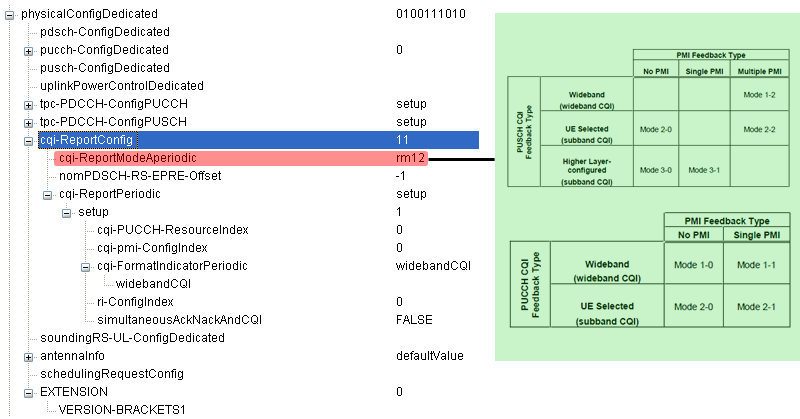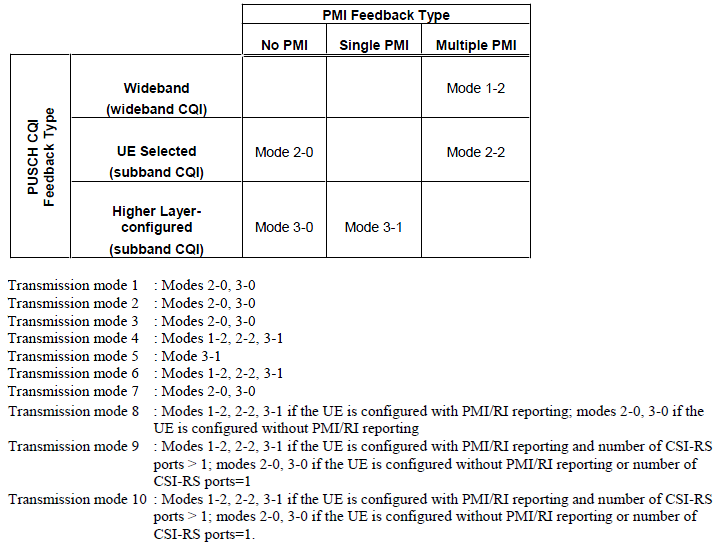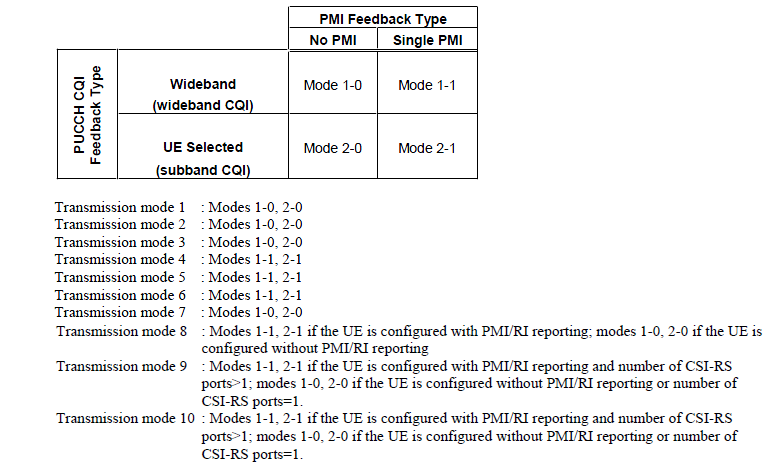|
NOTE : At high level view, it would not be difficult to understand overall concept of CSI. However, getting deeper into the details.. it would become much complicated .. and tooooooooooooo confusing (at least very confusing to me). That is one of the reason why I wrote multiple pages for the same topic (CSI). Multiple pages for the same topic can be additional confusion to some readers (even to me). However, I thought the page would get too big for download if I put everything in single page and I also thought it would not be bad to provide a little bit different aspect for the same topic with multiple post. But as I add more pages (post), I thought it would be good to write a page to provide high level view and help readers combine all those multiple pages that I wrote. Refer to CSI Overview page if you are not familiar with big picture of the CSI report.
CQI/PMI Feedback Type - Details of Aperiodic Report
There are two reporting modes in the time domain
- Periodic reporting: the UE reports CQI, PMI, and RI with reporting periods configured by the higher layer. PUCCH is used for this.
- Aperiodic reporting: can be used to provide large and more detail reporting in a single reporting instance via PUSCH. Report Timing is triggered by DCI.
For subbandCQI feedback
- In periodic reporting : The UE cycles through different subbandsfrom one reporting instance to the next, to reduce overhead
- In aperiodic reporting :
- Higher layer configured subbandreporting: UE reports the subbandCQI for each band in a single feedback report.
- UE selected subband report: UE reports the subbandCQI for the ‘M’ bands with the highest CQI values
What kind of Physical Channel does a UE has to use to report CSI (CQI, RI, PMI) ?
Following table from 36.213 gives you the answer. In short, UE use PUSCH to report CSI in aperiodic manner and use PUCCH or PUSCH for periodic report. (This used to be specified in 36.213 Table 7.2-1, but the table has become void since Rel 12 implying that the channel allocation for CSI report is not as clear as before.) Following is a new table based on my understanding taking into account many things in the situation in later 3GPP specification.
|
CSI Report Type
|
Physical Channel
|
|
Periodic
|
PUCCH : When no PUSCH is scheduled at CSI report subframe
PUSCH : When PUSCH is scheduled at CSI report subframe and Simultenous PUCCH and PUSCH is not enabled.
|
|
Aperiodic
|
PUSCH only |
Just considering the description mentioned above, it may sound like 'Periodic CSI report is conveyed only by PUCCH' and 'Aperiodic CSI reporting is conveyed only by PUSCH'.. but if you read carefully the following description (green part), you would notice that periodic CSI can be reported either PUCCH or PUSCH depending on the situation.
Just to give you a little bit of details/clarification, I put the descriptions about this from 36.213 Rel 8 and Rel 11 specification.
| 36.213 Rel 8 - 7.2 |
- A UE shall transmit periodic CQI/PMI, or RI reporting on PUCCH as defined hereafter in subframes with no PUSCH allocation. A UE shall transmit periodic CQI/PMI or RI reporting on PUSCH as defined hereafter in subframes with PUSCH allocation, where the UE shall use the same PUCCH-based periodic CQI/PMI or RI reporting
format on PUSCH.
- A UE shall transmit aperiodic CQI/PMI, and RI reporting on PUSCH if the conditions specified hereafter are met. For aperiodic CQI reporting, RI reporting is transmitted only if configured CQI/PMI/RI feedback type supports RI reporting.
- In case both periodic and aperiodic CSI reporting would occur in the same subframe, the UE shall only transmit the aperiodic CSI report in that subframe.
|
| 36.213 Rel 11 - 7.2 : The part marked in red is the part added in Rel 10 and higher |
- If the UE is configured with more than one serving cell, it transmits CSI for activated serving cell(s) only.
- If a UE is not configured for simultaneous PUSCH and PUCCH transmission, it shall transmit periodic CSI reporting on PUCCH as defined hereafter in subframes with no PUSCH allocation.
- If a UE is not configured for simultaneous PUSCH and PUCCH transmission, it shall transmit periodic CSI reporting on PUSCH of the serving cell with smallest ServCellIndex as defined hereafter in subframes with a PUSCH
allocation, where the UE shall use the same PUCCH-based periodic CSI reporting format on PUSCH.
- A UE shall transmit aperiodic CSI reporting on PUSCH if the conditions specified hereafter are met. For aperiodic CQI/PMI reporting, RI reporting is transmitted only if the configured CSI feedback type supports RI reporting.
- In case both periodic and aperiodic CSI reporting would occur in the same subframe, the UE shall only transmit the aperiodic CSI report in that subframe.
|
There are several different sub types of CQI and PMI. For example, Among CQI are Wideband CQI and Subband CQI and in Subband CQI there are two types of configuration, UE Selected and Higher Layer Configured.
In PMI, there are also two types Single PMI and Multiple PMI.
Then the question is exactly which type of CQI and RI a UE should report. Overall decision is made by the parameter in higher layer (RRC message) as shown below and the details of configuration is determined by various tables as described in this page.

CQI/PMI feedback type for Aperiodic report is defined by the following table (36.213) and cqi-ReportModeAperiodic in RRC message specifies exactly which type in this table should be used.
< 36.213 - Table 7.2.1-1: CQI and PMI Feedback Types for PUSCH CSI reporting Modes>

Somehow this table didn't look clear to me at the biggining. Following is my version. (Same story.. just different way of expression)
|
Modes
|
Report Item
|
Applicable TM
|
|
Mode 1-2
|
Wideband CQI, Multiple PMI
|
TM 4,6,
8(with PMI/RI),
9(with PMI/RI and #of CSI-RS > 1)
10(with PMI/RI and #of CSI-RS > 1)
|
|
Mode 2-0
|
Only Subband CQI(UE Selected), No PMI
|
TM 1,2,3,7
8(without PMI/RI),
9(with PMI/RI and #of CSI-RS = 1)
10(with PMI/RI and #of CSI-RS = 1)
|
|
Mode 2-2
|
Subband CQI(UE Selected), Multiple PMI
|
TM 4,6,
8(with PMI/RI),
9(with PMI/RI and #of CSI-RS > 1)
10(with PMI/RI and #of CSI-RS > 1)
|
|
Mode 3-0
|
Only Subband CQI(Higher Layer Conf.), No PMI
|
TM 1,2,3,7
8(without PMI/RI),
9(with PMI/RI and #of CSI-RS = 1)
10(with PMI/RI and #of CSI-RS = 1)
|
|
Mode 3-1
|
Subband CQI(Higher Layer Conf.), Single PMI
|
TM 4,5,6,
8(with PMI/RI),
9(with PMI/RI and #of CSI-RS > 1)
10(with PMI/RI and #of CSI-RS > 1)
|
CQI/PMI feedback type for Aperiodic report is defined by the following table (36.213). cqi-FormatIndicatorPeriodic in RRC message specifies exactly which type in this table should be used. (Regarding the timing of the report(period, offset), refer to here).
< 36.213 - Table 7.2.2-1: CQI and PMI Feedback Types for PUCCH CSI reporting Modes >

Somehow this table didn't look clear to me at the biggining. Following is my version. (Same story.. just different way of expression)
|
Modes
|
Report Item
|
Applicable TM
|
|
Mode 1-0
|
Only Wideband CQI, No PMI
|
TM 1,2,3,7
8(without PMI/RI),
9(with PMI/RI and #of CSI-RS = 1)
10(with PMI/RI and #of CSI-RS = 1)
|
|
Mode 1-1
|
Wideband CQI, Single PMI
|
TM 4,5,6
8(with PMI/RI),
9(with PMI/RI and #of CSI-RS > 1)
10(with PMI/RI and #of CSI-RS > 1)
|
|
Mode 2-0
|
Only Subband CQI(UE Selected), No PMI
|
TM 1,2,3,7
8(without PMI/RI),
9(with PMI/RI and #of CSI-RS = 1)
10(with PMI/RI and #of CSI-RS = 1)
|
|
Mode 2-1
|
Subband CQI(UE Selected), Single PMI
|
TM 4,5,6
8(with PMI/RI),
9(with PMI/RI and #of CSI-RS > 1)
10(with PMI/RI and #of CSI-RS > 1)
|
Following is the table showing which CSI report can be configured for which transmission mode. (Green color indicates that the specified CSI can be configured)
|
|
TM3
|
TM4
|
TM5
|
TM6
|
TM7
|
TM8
|
TM9
|
TM10
|
|
RI
|
|
|
|
|
|
|
|
|
|
PMI
|
|
|
|
|
|
|
|
|
|
|


